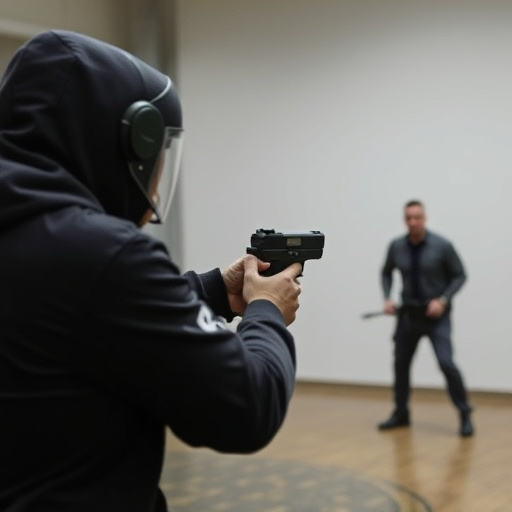Understanding voltage penetration is crucial for evaluating stun gun effectiveness, influenced by clothing material, thickness, device amperage, and voltage. Thin fabrics allow better penetration while denser materials like denim or leather reduce its effectiveness. Regular stun gun monthly maintenance, including cleaning, battery checks, and part replacement, ensures optimal voltage penetration during emergencies. Wearing thin, conductive fabrics facilitates electrical discharge for better stun gun performance. Using specialized equipment with regular calibration and proper testing practices is essential for accurate voltage penetration testing through thick clothing.
Voltage penetration through thick clothing is a critical factor in understanding the effectiveness of self-defense tools like stun guns. This article delves into the science behind how voltage traverses different fabrics, exploring key factors such as material type and thickness that impact resistance to electrical flow. We also provide essential stun gun safety guidelines and a monthly maintenance checklist to ensure optimal performance. By following best practices for testing and maintaining your stun device, you can be confident in its reliability when it matters most.
- Understanding Voltage Penetration: How It Works
- Factors Affecting Clothing's Resistance to Electrical Flow
- Stun Gun Safety and Monthly Maintenance Checklist
- The Impact of Fabric Type and Thickness
- Best Practices for Testing and Ensuring Effectiveness
Understanding Voltage Penetration: How It Works

Understanding Voltage Penetration: How It Works
Voltage penetration through thick clothing is a complex phenomenon that plays a significant role in the effectiveness of stun guns and similar devices. When a stun gun fires, it releases a high-voltage electric pulse designed to disrupt an opponent’s motor functions, causing them to temporarily lose control of their muscles. This disruption occurs due to the ionizing effect of the electrical current on the body’s cells.
The penetration depth of this voltage depends on various factors such as the thickness and material of the clothing, as well as the specific amperage and voltage output of the stun device. For instance, while thin fabrics like silk or cotton allow for better penetration, denser materials like denim or leather can significantly reduce the effectiveness of the stun. Regular maintenance of your stun gun, such as keeping it clean and ensuring proper battery levels, is crucial to guarantee optimal voltage penetration during emergencies, aligning with essential stun gun monthly maintenance tips.
Factors Affecting Clothing's Resistance to Electrical Flow

The resistance of clothing to electrical flow, or voltage penetration, is influenced by several key factors. First and foremost, the material composition of the fabric plays a crucial role. Different fabrics have varying levels of conductivity, with insulative materials like cotton and wool acting as natural barriers against electric current, while conductive fabrics like metal mesh or certain synthetic fibers can facilitate electrical flow. Thickness and density are also significant; thicker clothing provides more layers for electricity to navigate through, increasing overall resistance.
Additionally, the structure and construction of the garment contribute to its ability to deter voltage penetration. Seam placement, for instance, can disrupt the continuous path an electric current might otherwise take. Similarly, the presence of non-conductive thread or lining within a garment’s construction adds another layer of protection against electrical flow. These factors are particularly relevant when considering the effectiveness of clothing as a defense mechanism against low-let stun guns, underscoring the importance of regular maintenance—like cleaning and proper storage—to ensure optimal performance in emergency situations, as outlined in stun gun monthly maintenance tips.
Stun Gun Safety and Monthly Maintenance Checklist

Maintaining your stun gun is crucial for ensuring its reliability and safety. Here’s a stun gun monthly maintenance checklist to keep it in top condition:
1. Inspect the device thoroughly: Every month, carefully examine your stun gun for any signs of damage, corrosion, or wear. Check all components, including the battery, trigger, and contacts, for any anomalies. Replace any damaged parts immediately to maintain optimal performance.
2. Clean the stun gun: Use a soft cloth to wipe down the exterior of your stun gun. Avoid using harsh chemicals or abrasive materials that could damage the device. For the internal components, use a dampened cloth to gently clean the contacts and battery terminals. Ensure everything is thoroughly dried before reassembling.
3. Check battery health: Stun guns rely on high-quality batteries for their effectiveness. Regularly test your battery’s charge level using a dedicated charger or multimeter. Replace any battery that shows signs of deterioration or fails to hold a charge, as this could impact the stun gun’s overall performance and safety.
4. Lubricate the trigger mechanism: To prevent stiffness and ensure smooth operation, apply a small amount of lubricant to the trigger mechanism, following the manufacturer’s instructions. This simple step can significantly enhance the stun gun’s usability over time.
The Impact of Fabric Type and Thickness

The effectiveness of voltage penetration through thick clothing is significantly influenced by the type and thickness of the fabric. Different materials exhibit varying levels of conductivity, which play a crucial role in determining how easily electrical current can pass through them. For instance, thin, conductive fabrics like metal mesh or certain types of synthetic fibers allow for better current flow compared to thicker, non-conductive materials such as denim or leather.
When considering stun gun monthly maintenance tips, understanding fabric types is essential. Thicker clothing can provide additional protection against electrical discharge, making it more challenging for a stun device’s current to penetrate and deliver its intended shock. This is why lighter, bulkier fabrics are often recommended for optimal stun gun performance. Regularly assessing and maintaining the condition of your clothing, especially if you frequently carry a stun gun, can help ensure maximum effectiveness in self-defense situations.
Best Practices for Testing and Ensuring Effectiveness

When testing voltage penetration through thick clothing, it’s crucial to follow best practices for ensuring accurate and reliable results. Start by using specialized equipment designed to simulate real-world scenarios, such as stun guns with adjustable settings. Calibrate your devices regularly according to manufacturer guidelines, especially considering the importance of monthly maintenance tips for optimal performance.
Additionally, select appropriate test subjects or materials that closely mimic the clothing expected in potential field situations. Always conduct tests in a controlled environment and document each step meticulously. Regular cleaning and upkeep of testing equipment are vital to maintaining accuracy and ensuring every test yields valid data.
In understanding voltage penetration through thick clothing, especially in the context of stun gun safety, it’s clear that regular maintenance is key. Following best practices for testing and our detailed stun gun monthly maintenance checklist ensures optimal effectiveness. By considering fabric types and their resistance to electrical flow, users can make informed decisions, enhancing both personal safety and the reliability of their equipment. These insights empower individuals to navigate potential risks with confidence, knowing they’ve taken proactive steps to maintain their stun gun’s integrity.
